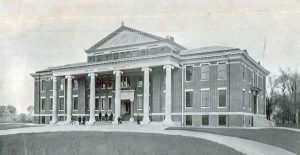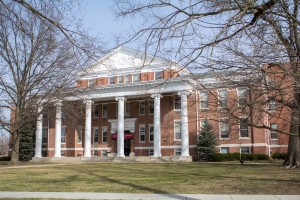University Archivist and Associate Librarian Christine Guyonneau began working at the University of Indianapolis in 1987, where she continues to work to this day. She said that the school has changed quite a bit since then, but even more so in the time since it was founded on Oct. 6, 1902.
The University of Indianapolis, or Indiana Central University as it was known back then, started out as a simple idea from the Church of the United Brethren in Christ to fulfill the need for a college that would follow its own religion and beliefs, according to Guyonneau. A developer and landowner said that he would give the land and a building for the university if the church conferences helped him sell 446 lots. Guyonneau said the offer was accepted, and Indiana Central was given lot #447, which consisted of eight acres of land estimated at $15,000 and a building estimated at $40,000. Fifteen thousand dollars is equal to around $416,000 today, and $40,000 is equal to about $1.1 million today.
The first building was called the Administration Building and is still standing today, Guyonneau said, but is now known as Good Hall. This building held classrooms, offices, a library and a chapel that could hold up to 800 people. According to Guyonneau, it was mandatory for students to attend chapel every day then.


“The first president, J.T. Roberts, lived with his wife and children in the [Administration] Building because that was the only building available,” Guyonneau said. “The wife was cooking for the whole faculty and students.”
The university began enrolling students in 1905, and students paid an enrollment fee of $3, equal to $83 today. Guyonneau said that tuition per semester for full term was $12, equal to $333. Winter term also was $12. Spring term was $10, equal to $278, and summer term was $6, equal to $167. She said all necessary expenses for the school year ranged from $125 to $175, about $3,472 to $4,861 today.
The first graduation ceremony took place in 1908, and there were only two graduates, Guyonneau said, one of which was named I.J. Good. After Good became the third president of the university in 1915, the Administration Building was renamed Good Hall in his honor.
The university’s first international student, David Manly, arrived in 1919 and was brought here by a graduate of Indiana Central University.
“Ernest Emery and his wife graduated in 1915, and a month later, they went as missionaries to Sierra Leone,” Guyonneau said. “While they were there, he [Emery] met a young man who was a teacher and was eager to advance.… He found some sponsors here, on campus, and he [Manly] was the first international student.”
In 1921, the first dorm, Dailey Hall, was built where the alumni house is now located. In that same year, Guyonneau said, there was a temporary gymnasium where the university’s sports teams practiced. The gymnasium was used from 1921 to 1959, when it was replaced with Nicoson Hall.
During the 1940s, the university set rules about how students should behave that probably seem a little strange now, Guyonneau said. For example, females were only allowed to go with males in automobiles when they had permission from the dormitory matron or dean of women, and the use of profanity could result in disciplinary action. Students could not smoke either inside or outside buildings, and gambling and alcohol were prohibited. Guyonneau said that there was even a rule saying, “Wise girls avoid all extremes in both dress and makeup.” The president at the time, Lynd Esch, had found out that some young women had worn shorts on campus during the summer, which was deemed inappropriate.
The university continued to develop through the years, according to Guyonneau, with some highlights. The Campus Apartments, which were recently demolished this past summer, were built in 1952. The first co-ed dorm was built in 1969, with males on one side and females on the other. And in 1972, the first two male nursing students were admitted to Indiana Central.
Starting in 1981, Professor of Psychology John McIlvried joined the faculty at Indiana Central. He worked full-time until 1985, when he left to work as the chief psychologist at Central State Hospital, but continued to work at the university as an adjunct professor. He returned to teaching full-time in 1993 and has been here since. McIlvried has worked at the university for a total of 35 years, counting the adjunct work.
He said that since 1981, he has seen some changes in the student body and found success in many of the programs the school offers.
“A higher percentage [of students] were in-state, local, commuter, first-generation, kinds of people,” McIlvried said. “And now, of course, we’ve got these programs that have drawn large numbers of international students, and we have a higher percentage of out-of-state students who are coming here. Some of our graduate programs have really taken off: PT [physical therapy], OT [occupational therapy], psychology…. Having doctoral programs in those areas has really broadened our draw.”
One of the major changes to the university was the name change from Indiana Central University to Indiana Central College then back to Indiana Central University. It was the changed to the University of Indianapolis in 1986, McIlvried said. It was given the nickname UIndy in 2006 for marketing purposes.
Since the 80s, UIndy has changed a great deal physically, he said, with the main difference being that there was once a parking lot where Smith Mall is today. It was changed in 1998 to make the university more aesthetically pleasing. Other physical changes included the addition of new dorms and expansions to buildings such as Esch Hall and the Schwitzer Student Center. More recent changes were the renovation of the library and the building of the Health Pavilion.
McIlvried also said that there have been great technological advances since he started working at UIndy.
“There weren’t any computers when I first started,” McIlvried said. “Everything had to be done [with] paper and pencil or in person. There wasn’t email or texting or any of these things…. We now have a lot of hybrid courses, where some is taught face-to-face and some [content] is online. We are getting more and more completely online courses.”
According to McIlvried, all of the changes made to UIndy since 1902 have helped shape the identity and image of the university.
“Change is never easy for people, whether it’s students or clients, if you’re seeing people in therapy,” McIlvried said. “I think oftentimes change is important and good, but it’s not always good. I think the question becomes, a university or an organization has a sense of identity, just like you or I have a sense of who we are. At a broader level, the university develops a sense of identity because of the faculty and the students. They have a sense of ‘This is what this place is like. This is who we are.’”






